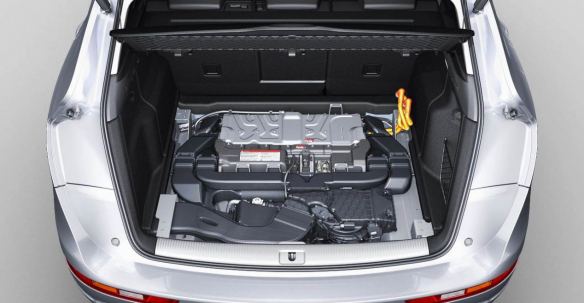Battery
The battery in an electrified vehicle powertrain is a highly complex system. The lithium-ion technology offers opportunities and challenges in a number of areas – weight, energy, the package, safety, lifetime and, not least, cost.
Lithium-ion batteries supply a largely constant voltage and are thermally stable over wide ranges. They have little self-discharge and are not subject to any memory effects. Development work is currently being carried out at a feverish pace. For the components of the cells alone – the anode, cathode, separator and electrolyte – up to 40 materials are available for each component. Audi distinguishes between two basic types of lithium-ion battery. High-performance batteries are suitable for use in hybrid vehicles. High-energy batteries, by contrast, are designed for vehicles traveling longer distances under electric power.
The energy that can be stored by a battery is stated in kilowatt hours (kWh). By relating the energy to the battery’s mass, we obtain the energy density. At present lithium-ion batteries in the automotive sector have an energy density of about 0.14 kWh per kilogram. In light of this trend, an energy density of 2.5 kWh per kg can be expected by 2020. For comparison: one kilogram of gasoline (about 1.33 liters (0.35 US gallons)) contains about 12 kWh of energy.
The lifetime of a lithium-ion battery in the vehicle can be estimated at ten years or more, if the battery is kept at a moderate temperature. Equally as important as the seasonal factor are the load profile and the intensity of the charging and discharging cycles – regular quick charging with heavy current shortens the lifetime, as does frequent total discharge. High-performance batteries are generally discharged to about 50 percent state of charge (SOC); high-energy batteries have a lower limit of about 20 percent. If these limits are maintained, the batteries can undergo several thousand charging and discharging cycles before their power appreciably declines.
Overcharging and total discharge must also be avoided because they can destroy the cells. Comprehensive safety precautions minimize this risk – the temperature is precisely monitored by sensors, while electrical fuses and pressure relief valves in the cells prevent chain reactions in the system.
Because flowing currents generate significant amounts of heat, a cooling system is required to maintain the battery within the appropriate range of approximately 25 to 45 degrees Celsius (77 to 113 degrees Fahrenheit). Higher and lower temperatures shorten the lifetime – higher temperatures do this even if the battery is not under load. The job of the cooling system (either air or liquid systems can be used) is to even out most of the temperature differences among individual cells.
Audi and other carmakers are working together with the German Automobile Industry Association to develop uniform standards for battery cells. Prismatic cells, which are of primary interest here, generate between 500 W (for hybrid vehicles) and more than 1,500 W (for heavy-duty electric vehicles). Their capacity begins at about 130 cm3 (8 in3) and ends at just under 900 cm3 (55 in3). Compared with round cells, flat cells have a large surface area relative to volume, which means that they can dissipate heat very well. They also can be packed together to save space.
Other components round off the battery system, namely the high-voltage and service connections, the electronic battery management system, the electro-mechanical components, the housing and the sensors and actuators. All of these components and their assembly account for the fact that the cost still remains high: lithium-ion batteries cost several hundred euros per kilowatt-hour. Audi expects this price to drop by 50 percent over the next ten years.
Status: 2011
